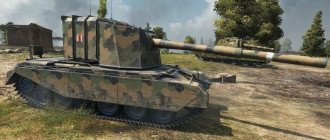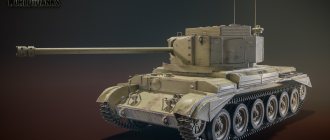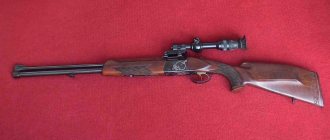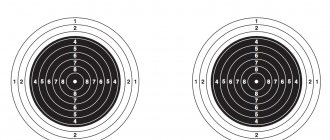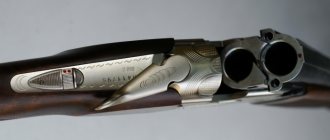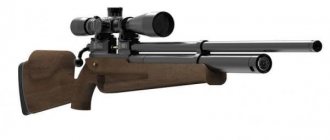The TOZ-34 hunting rifle is a classic double-barreled shotgun with a vertical barrel arrangement, which is still produced by the Tula Arms Plant. The simple design, reliability and light weight of the gun made this double-barreled shotgun incredibly popular among domestic hunters.
The TOZ-34 hunting rifle was first presented at the Leipzig fair in 1965, where it was not only immediately noticed, but also awarded a gold medal for its original design, which was a huge achievement for hunting rifles in the USSR. After mass production began, and this happened in 1969, every Soviet hunter dreamed of purchasing a TOZ-34 shotgun, preferably 12 gauge. Although we had to wait 4 whole years after the brilliant performance at the German exhibition, they were not in vain - an ejector appeared on the 1969 models. Another improvement appeared in 1978, when a disassembly flag appeared on the TOZ-34.
History of creation
Korovyakov came to the Tula Arms Plant after the army, in 1959. Having received the position of design engineer, Nikolai Ivanovich began to work. The young engineer was noticed and given a hunting rifle to develop.
In collaboration with Ferapontov S.S., Paramonov V.A. and Ochnev V.P. Over the course of several years, this sideflint was created. It is worth noting that all developments were carried out practically from scratch. We can say that there was no mass production of high-quality smooth-bore weapons in the USSR.
After development, the gun was taken to the international fair in Leipzig, where it received a well-deserved award. And since 1969, serial production of the new TOZ-34 hunting rifle was launched at the Tula plant.
Berdanka for the Russian Tsarist Army
Having carefully familiarized themselves with the design and features of the Berdan system rifle, Russian officers agreed to purchase a patent for the tsarist army, but put forward a number of mandatory conditions for the modification of the rifle and its ammunition. All comments were taken into account, especially since the American designers were joined by a whole team of Russian weapons specialists who adjusted the improvements taking into account the characteristics of the Russian weapons industry.
After carrying out the necessary modifications, the drawings of the rifle, called the “1868 model rifle rifle”, or as it was called in the USA “Russian”, were sent to the Colt plant for serial production of the first batch of weapons.
The new army rifle had the following features:
- The main difference from the old Russian rifles was a completely new ammunition, four-line caliber. If we translate this into a measurement system that is more understandable to us, then this caliber will be equal to 10.7 mm;
- The cartridges for the new rifle became seamless. The first cartridges had brown smoky powder, later it was replaced with smokeless powder, since the use of smoky powder unmasked the shooter;
- The bullets were first traditionally cast, then switched to stamping technology, which significantly speeded up the production process;
- The bullets for the Berdan rifle were non-jacketed, which gave rise to the Germans accusing Russia of using inhumane weapons that inflict fatal wounds;
- Another feature of the Russian Berdanka was its tetrahedral bayonet, which, although seemingly quite thin and harmless, inflicted more terrible wounds than the wide knife-type bayonets used by the armies of other European states.
Design
The TOZ-34 shotgun is a hammerless sideflint. It was the design of the fracture unit that brought fame to Korovyakov and his brainchild. The TOZ-34 uses ring hinges, which made it possible to lower the barrels and increase the durability of the hinge.
But, at the same time, it is ring joints that require the highest qualifications of personnel and the precision of machines during manufacturing. Some TOZ-34E shotguns were equipped with an ejector.
The weapon was cocked when the barrels were broken for reloading. Separate barrel control, two triggers. To prevent an accidental shot, there is a push-button safety, located either behind the lever or on the neck of the butt.
Structurally, the gun consists of a butt with a pistol neck, a receiver in which the trigger is located, a block of barrels and an integral forend. The forend and buttstock of production weapons are made of birch or beech. For individual or souvenir execution, walnut is used.
The trunks in the block are placed vertically, with a slight overlap of the center lines.
They were united by a massive breech coupling, common to all calibers of this gun.
The unification of production led to this decision. Although this greatly improved the durability of smaller caliber guns. The upper one has a muzzle constriction of 1.0 mm, the lower one is 0.6 mm, the channels are chrome-plated.
Length – 711 mm for 12 gauge, 660 for all others. Chamber for 70 mm, magnum cases, 76 mm, not used. An aiming rib runs along the top surface of the barrel.
TOZ-34 was produced in all hunting calibers, these are: 12, 16, 20, 28 and 32. However, the other mechanisms did not change. TOZ-34 20 caliber differed from the 16th or 12th only in the length and diameter of the barrels.
Depending on the design, four varieties were produced:
- Ordinary, birch stock, mechanical engraving of the ornament;
- Ornamental design, sometimes called TOZ-34 gift, beech stock, mechanical engraving in the form of a floral ornament;
- One-piece execution, selected barrels with good accuracy, walnut stock, artistic mechanical engraving;
- Souvenir weapons, selection of the best barrels, walnut and valuable wood species, increased area of artistic coinage and hand engraving, use of precious metals in decoration.
But it was ordinary and gift guns, despite their mass production and satisfactory build quality, that were appreciated by hunters.
The fleeting military career of the Russian Berdanka
The Berdan system rifle served as the main rifle of the Russian army for a fairly short period of time; already in 1885, its mass replacement began with Mosin system rifles, which were multi-shot. Despite this, the military industry of Tsarist Russia managed to produce several modifications of the Berdan system rifle:
- The most numerous and widespread was the infantry version of the rifle;
- The Dragoon version had a shorter barrel;
- The Cossack version was distinguished by the absence of a trigger guard;
- The rarest was the carbine version. It was a special shortened and lightweight gun. The bayonet was not installed on it. The carbine cartridges had a lighter weight of gunpowder. After some time, the production of this carbine was considered inappropriate, so it was quickly discontinued.
Various modifications of the Berdan system rifle differed in both barrel length and different types of wood used to make stocks and butts.
After all Berdan system rifles were replaced in the army with Mosin rifles, the question arose about using the huge number of Berdan rifles that remained in army warehouses. Since it was economically unprofitable to send such a quantity of excellent weapons for melting down, it was decided to proceed as follows:
- A small percentage of Berdankas should be left for military educational institutions;
- Some of the rifles will be transferred to the arsenal of security guard services and auxiliary units;
- It was decided to preserve the bulk of the rifles as a mobilization reserve.
After some time, rifles of the Berdan system were allowed to be sold as a set of parts for conversion into hunting weapons to the population and in batches to factories for factory conversion into weapons for hunting.
Specifications
The parameters of a hunting smoothbore weapon depend on the making of the barrel channels and their relative position. In the case of TOZ-34, they are located vertically. It is worth briefly mentioning the muzzle constriction; this is a characteristic of a smooth-bore weapon that affects the spread of the shot along the cone.
Accuracy parameters for 12 gauge:
| Execution | Upper barrel, range 35 m, target diameter 750 mm, % | Lower barrel, range 35 m, target diameter 750 mm, % |
| TOZ-34, ordinary and ornamental | 60 | 50 |
| TOZ-34, piece and souvenir | 65 | 55 |
The weight of the TOZ-34 weapon is 3.15 kg, with good balance. Which in turn allows you to achieve good accuracy when shooting offhand.
It should be noted that when using metal cartridges, the accuracy of the weapon is slightly reduced.
Also, changes in accuracy are noted when using ammunition from different manufacturers.
Self-loading of cartridges must be done in a dry place, without open sources of fire.
Also in this section:
Hunting rifle TOZ-63
01.01.1970
Section: "Directory"
Technical characteristics and principle of operation.
Read →
Main varieties
The TOZ-34 side flint was produced in several basic modifications. The main differences were in the design of the butt, the trigger and the presence of a mechanical ejector system.
An ejector is a mechanical extractor, needed to eject spent cartridges during reloading.
In a conventional gun, the ejector tooth only removed them halfway from the chamber. Then they are pulled out with your fingers, the device is quite successful, but only when using cartridges with reusable cartridges, so they do not need to be collected around the clearing.
The following serial modifications of the TOZ-34 are known:
- TOZ-34R, with a soft butt plate, sometimes there was a cheek;
- TOZ-34E, with an ejector mechanism, as well as the EP model;
- TOZ-34-5.6/28 produced in a small batch of bokbyuksflint, the upper shotgun is 5.6 mm “Long Rifle” caliber, the lower shotgun is 28 or 20;
- TOZ-34-1, single-barrel 12-gauge fishing shotgun using a TOZ-34 ring joint. It is lightweight and adapted for use with a 30 cm long threaded insert;
- TOZ-55 “Zubr”, commercial bokbyuksflint, based on TOZ-34, 12th upper, lower - rifled for fitting 9x53 mm;
- TOZ-34M, has a more modern look and a groove for an optics bracket.
There were also a number of experimental and piece samples assembled in the likeness of the TOZ-34 gun; they were not described or distributed. It is also worth noting the SHP based on this gun and chambered for 10x31.
The mass-cut version is perfect for decorating the hall of a professional hunter. Typically, these are deactivated weapons in excellent condition, but do not require storage in a safe and are safe for others.
Disassembly
Disassembly is carried out to clean and lubricate it, as well as to replace failed or worn parts.
First of all, before disassembling the weapon, you need to make sure that there are no cartridges in the chamber of the weapon.
After this, you need to make sure that the locking lever is located along the axis of the gun, and the safety catch is lowered all the way down.
- After checking the barrels and the control, which is mandatory, the release, you need to turn the locking lever to the right;
- Lower the barrels down and remove the breech coupling from the box axle with a rotational movement. Then return the locking lever to its previous position. This is enough to clean the weapon. But if the gun has been in water or drowned in a swamp, you need to disassemble it and thoroughly wipe and lubricate it. The procedure for disassembling the TOZ-34 extractor must be carried out carefully; excessive pressure can lead to failure of the ejector brackets;
- After unscrewing the screws of the forend, remove the lining;
- Use a hammer to knock out the hinge pin;
- Unscrew and remove the ejector ejectors, holding the springs;
- Unscrew and remove the rear screw on the safety bracket, and then remove the bracket itself. Unscrew the star-shaped bolt on the bottom surface of the receiver;
- Remove the entire trigger block;
- Disassemble the trigger, paying special attention to the springs.
Care
Cleaning the weapon is mandatory, especially after intense shooting, but periodic lubrication of the weapon is also a good idea.
Then perform partial disassembly. Clean the mechanism parts, wipe with a clean soft cloth until all traces of dirt, carbon deposits and soot are removed, then apply a thin layer of neutral gun oil “Glukhar” or “Ballistol” spray.
To clean your weapon, you should purchase a special kit that includes all the necessary brushes, wipes, and a cleaning rod.
Pay attention to the material of its rod; it should be either covered with plastic or wood. You can also use a cleaning rod cord.
Clean the barrels in the direction from the breech to the muzzle. First remove the carbon deposits, then wipe with a clean rag. There should be no spots in the trunk when exposed to light.
It is enough to simply wipe the wood parts of the weapon dry; lubricating them with weapon lubricants is not recommended.
The last massive military use of Berdan guns
When the hunting market was saturated with weapons made on the basis of rifles of the Berdan system, a huge number of them continued to be stored in warehouses. As it turned out, the rifles were not stored in vain. With the outbreak of World War I, the tsarist command again had to use the old Berdan guns. At first, they were armed with rear units that guarded defense and strategic facilities, and then, when the enemy managed to capture and destroy part of the weapons depots, Berdan rifles were sent to the front line.
Soon, the Russian military industry began to work in emergency mode, and the army received a huge number of Mosin rifles, which were enough not only for the First World War, but also for the Civil War in Russia.
Currently, most of the surviving rifles and hunting rifles of the Berdan system are in museums and private collections. It is very rare in taiga villages to find miraculously preserved hunting rifles of the Berdan system, which were carefully passed down from generation to generation. Such guns are true hunting relics.
Tuning
For tuning, the selection of the highest quality barrels is used, the forend and stock are replaced with ones more convenient for the owner, many install low-power optical sights or collimators with a Weaver or Piccatini rail. The bracket under it is attached to the receiver.
It should be noted that three-point belts are becoming widely popular, which increase the comfort of transporting weapons and speed up the transfer from traveling to combat position. In addition, additional bandoliers and butt cheeks are often used.
Advantages and disadvantages
The advantages are considered to be the simplicity of the device and operation, with a somewhat complicated procedure for disassembling the TOZ-34 gun. Excellent balance, good grouping of piece barrels.
But at the same time, the disadvantages of this weapon lie in the low production culture. Some parts are made of low-quality steel and quickly fail, especially often parts of ejector mechanisms and springs.
The protective coating of metal parts wears off quite quickly, and pockets of corrosion appear. For this reason, the weapon requires constant care. The quality of manufacturing of wooden parts of ordinary weapons is also not encouraging.
It is necessary to note the unification, the barrels of all calibers are united by a 12-gauge coupling, which is too large and heavy for 20 and 32, the only consolation is that such a strength reserve gives the weapon a longer lifespan.

